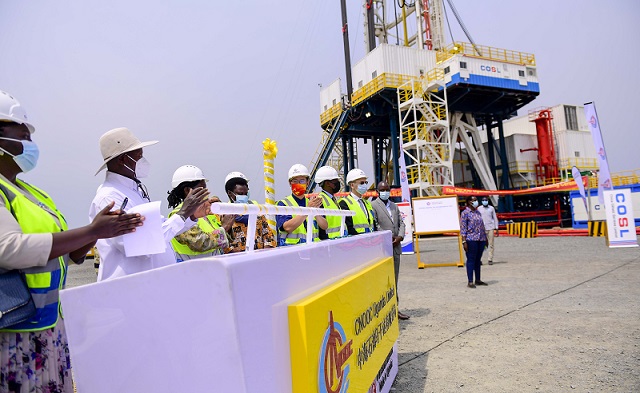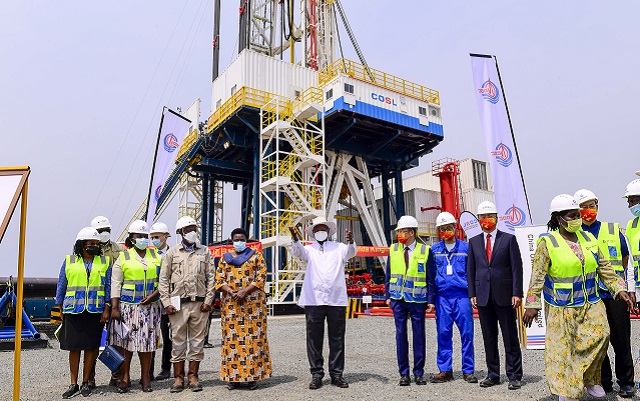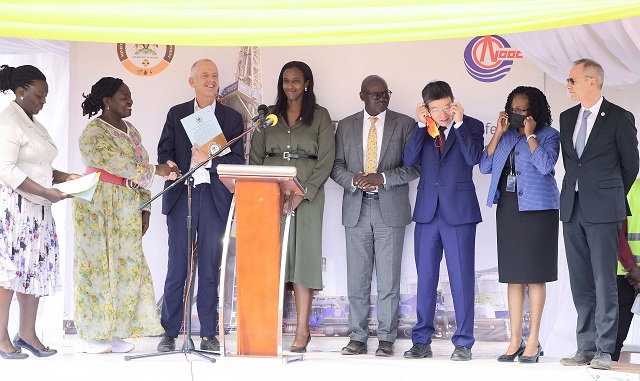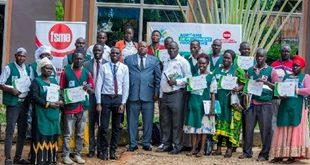
What it means in numbers and money
COVER STORY | RONALD MUSOKE | As President Yoweri Museveni and his ruling NRM party celebrate their 37th year in power, the Chinese National Offshore Oil Corporation (CNOOC) has given them a befitting anniversary gift; launching the country into crude oil production stage.
Uganda’s Liberation Day, when Museveni’s rebel army captured power in 1986, is marked on January 26 with a public holiday and celebrations across the country.
But the high point of the celebrations this year came two days earlier, on Jan.24, when CNOOC launched the start of its drilling for oil at a high-level event at its Kingfisher Oil field in Kyangwali Sub- County, Kikuube District in mid-western Uganda.
CNOOC launched the drilling which will cover several oil wells in the Kingfisher oilfield ahead of production which the government has now scheduled for 2025. The ceremony to mark the start of drilling of the oil wells technically known as “spudding” was graced by President Museveni and other senior officials of the government and the oil companies.
A beaming Museveni thanked CNOOC for hitting the milestone and advised the locals of the area to plant more food crops to feed the anticipated influx of workers in the oil production phase.
“That is one of the areas where you can tap wealth,” he said.
Museveni used the opportunity to reassure the world of the country’s resolve to exploit its oil and gas resources sustainably. The President recapped how the patience of his NRM Government to develop the resources had led to this, among other key milestones.
“I was approached by the Dutch company, Shell, to give them the go-ahead to look for this oil, but I hesitated after finding out we did not have any Ugandan experts on oil,” he said.
Museveni noted that it would be best if other leaders in Africa take a lesson from him to avoid bumping into things they do not know much about; ‘Okutomera’ in Luganda. “If you’re not sure of something, ask and you’ll be helped,” he said.
The President hailed the Chinese and French Governments for the continued support offered to Uganda to develop her resources. He said he was not amused by the European Parliament (EU) resolution that called for halting Uganda’s oil project.
Hours after the spudding ceremony, civil society organisations in both Uganda and the Democratic Republic of Congo issued a joint statement calling on the government, CNOOC and TotalEnergies to prioritise the economic well-being of Ugandans, biodiversity conservation and climate action by investing in clean energy instead of climate-wrecking projects such as Kingfisher, Tilenga and the East African Crude Oil Pipeline (EACOP) projects.
The CSOs said they are still concerned that the Kingfisher project involves drilling of 31 oil wells, some of which are onshore (underneath the surface of Lake Albert).
“Ugandans, East Africans and indeed all global citizens of goodwill should be concerned about the Kingfisher, Tilenga and EACOP oil projects. The projects are located in one of the last frontiers for biodiversity conservation—the Albertine Graben—in Uganda. The Graben is home to forests, 70% of Uganda’s national parks, major lakes such as Albert, River Nile and others,” Dickens Kamugisha, the CEO of Africa Institute for Energy Governance, said.
“These ecosystems and biodiversity support Uganda’s major economic activities such as agriculture, fishing, tourism and business. By endangering biodiversity therefore, the joint venture partners are risking the majority of Ugandans’ economic well-being.”
US$2 billion investment
Ernest Rubondo, the executive director of the Petroleum Authority of Uganda (PAU) which oversees the oil and gas sector in Uganda also focused on the potential wealth to be minted from oil. He reeled off a battery of numbers.
Rubondo said investment in the development of the Kingfisher oilfield is expected to cost over US$2 billion over the next three years, until shortly after production starts. Thereafter, it will cost over US$1.5 billion over the remaining 20 years of the life of the oil field.
“U.S. dollars 346 million was invested in the Kingfisher project in 2022, bringing the total cumulative investment in the project to U.S. dollars 1.07 billion at the end of 2022,” he said. He added that about US$580 million is expected to be invested in the Kingfisher Development Area in 2023 and a similar amount in 2024.
Chen Zhuobiao, the vice president of CNOOC Uganda Ltd said the locals would get more job opportunities during the well drilling and in the completion process. He said more local talent would be trained for the oilfield development stage and bring tangible changes to local communities.
He said his company would begin drilling the development and production wells using the state-of-the-art LR8001 Drilling Rig. There are 31 production wells in this oil field that are on schedule for drilling. Twenty of these will be used to produce oil, while 11 will be used to inject water into the reservoir to help improve production.

“The deluxe rig is expected to drill up to 8000m deep while providing maximum efficiency with minimal environmental impact,” Zhuobiao said.
The brand-new state of the art rig was specially designed for the Kingfisher field and is the strongest that has been used in the country to date consuming about six megawatts of power. It has the capacity to drill up to 8km long, with noise suppressing technology making it more environmentally friendly.
Preparation for spudding
The spudding event followed several months of designing, manufacturing, loading, transportation, installation and preparation for the spudding operation. The components of the rig were first loaded on a ship at the Chinese port of Yantai on July 29, last year, and arrived at the Kenyan port of Mombasa in September. The rig machinery was then hauled by trucks to the western district of Kikuube which hosts the Kingfisher oil field and assembling of the rig began until November.
“It took the course of 270 days to complete the design, manufacturing, transportation, installation and preparation for the spudding operation,” said Chen Zhuobiao.
The Kingfisher oil field is the smaller of the two commercial oil development projects in Uganda so far. The bigger one is Tilenga operated by the French oil giant, TotalEnergies SE.
The Kingfisher Field Development Plan, which Ruth Nankabirwa, the Minister of Energy and Mineral Development said she has approved, provides that when production at this oil field begins to decline, the company starts production from the other three oil fields; Waraga, Mputa, Nzizi in the Kaiso Tonya Area in Hoima District which is 40km north of Buhuka.
Nankabirwa said production from these three oil fields will enable CNOOC to maintain production at the Kingfisher project. The crude oil from these fields will be transported by pipeline to Kingfisher for processing.
The Kingfisher oil field was formerly part of Exploration Area 3A, which was in 2004 licensed to Heritage Oil and Gas in joint venture with Tullow Uganda Operations Pty Ltd (Tullow) under production sharing agreements EA 3A and Heritage as the operator.
However, Heritage later farmed out their interests of the licence to Tullow, which later in 2012 together with the government arranged the farming in of CNOOC and TotalEnergies EP Uganda B.V (TotalEnergies) in the license, with CNOOC as the operator.
This oil field which is perched on the southeastern shores of Lake Albert is about 15km long, 3km wide and 2km below the lake’s surface. It is estimated to have a total of 560 million barrels of oil in place, out of which 190 million (33%) are expected to be tapped over 20-25 years.
The oil field is expected to produce a maximum quantity of 40,000 barrels of oil per day for five years, after which production will begin to decline.
The spudding ceremony comes less than one year after the announcement of the Final Investment Decision (FID) for the upstream and midstream East African Crude Oil Pipeline (EACOP) projects.
CNOOC held a ground-breaking ceremony to mark the commencement of the construction at its Kingfisher Oil Field on Feb. 11, last year, just ten days following the announcement of the final investment decision (FID) for the country’s oil and gas projects.
According to the Petroleum Authority of Uganda, the Kingfisher Development Area has gone through various succession phases which implies it has involved many players from the energy ministry, local government, other central government ministries, departments and agencies.
“This project has come from far and CNOOC has done commendable work and related very well with the local communities through constructive stakeholder engagement, transparent land acquisition processes and resettlement plans, construction of the Escarpment Road, plus pre-drilling civil works for the Kingfisher Development Project,” said Rubondo.

Still, Rubondo noted that PAU remained committed to ensuring sustainable and responsible project development of Uganda’s oil and gas projects.
“The PAU is working with the National Environment Management Authority (NEMA) and other agencies to ensure the strictest environmental and safety practices and technology in the planning, execution and decommissioning of the oil and gas projects in Uganda, including at this Kingfisher project,” said Rubondo.
He said PAU also intends to implement a Real-Time Monitoring Centre (RTMC)— a facility designed to receive and relay information from all the activities in the oil and gas sector in real-time. “It will be in place before the end of 2024,” he said.
New ambitious plan
Ruth Nankabirwa, the energy minister revealed that the country has embarked on an ambitious process of encouraging more exploration to discover more resources to take advantage of the new infrastructure being put in place.
“Government announced the Second Licensing Round in May 2019 with five blocks on offer. The Cabinet this month approved the issuance of Production Sharing Agreements for two of the blocks, Turaco and Kasuruban Blocks and grant of their respective Exploration Licenses,” she said.
The Minister also used the event to issue the East African Crude Oil Pipeline (EACOP) construction licence to EACOP Limited, which Martin Tiffen, the company’s managing director, received on behalf of the partners.
“The company applied for a license in July 2022 to construct the pipeline. We reviewed the application, held several discussions, found it satisfactory, and subsequently sought approval from the Cabinet for the grant of license. Last week, the government approved the issuance of the license,” Minister Nankabirwa said.
The license grants EACOP Ltd a go-ahead to start construction works in Uganda as part of the development of the 1,443km crude oil pipeline that will transport Uganda’s oil from Kabaale terminal, which is found Hoima in Uganda, to the port of Tanga in Tanzania.
Irene Batebe, the Permanent Secretary at the Ministry of Energy and Mineral Development, said the government’s commercialization plan provides in-country value addition through refining, where they plan to develop a 60,000 barrels per day oil refinery.
“Alongside the refinery, the government, through UNOC, is developing the Kabaale petro-based industrial park in Hoima,” Batebe said.
During the Annual Press Brief on the Oil and Gas held on Jan. 20, Nankabirwa revealed that the Final Investment Decision (FID) for the Refinery Project is expected by June this year.
The waste generated from the Kingfisher project will also be managed by a consortium of a Ugandan company, Luweero Industries Limited (a subsidiary of NEC) and an international firm, BHP, from China.
At the ceremony in Buhuka, Chen Zhuobiao, the vice president of CNOOC Uganda Ltd noted that the coincidence of the spudding of the Kingfisher oil wells with the Chinese New Year made the CNOOC executives believe that 2023 is going to be a year of good luck. Many Ugandans hope the Chinese executives are right.
 The Independent Uganda: You get the Truth we Pay the Price
The Independent Uganda: You get the Truth we Pay the Price


